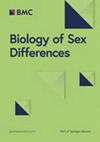接受门诊肺康复治疗的科维德后患者的性别差异
IF 4.9
2区 医学
Q1 ENDOCRINOLOGY & METABOLISM
引用次数: 0
摘要
在被称为 Covid-19 的严重急性呼吸道综合征冠状病毒 2 感染大流行多年后,被概括为 "后 Covid 综合征(PCS)"的长期损伤给全球医疗保健带来了挑战。患者从康复计划中获益匪浅,但对改善性功能的具体方面仍然知之甚少。这项研究旨在评估女性和男性对 PCS 门诊肺康复治疗的反应是否存在差异。一项前瞻性观察性队列研究纳入了 2020 年 3 月至 2022 年 7 月期间因 PCS 而参加门诊肺康复(OPR)的 263 名患者(54.4% 为女性)。研究结果在基线和出院前进行评估,包括六分钟步行距离(6MWD)、1秒用力呼气容积(FEV1)、一氧化碳弥散能力、最大吸气压力(MIP)、呼吸困难(医学研究委员会量表)和科维德后功能状态量表(PCFS)。通过线性混合模型评估了OPR后不同性别患者的结果变化,并以均值差异(MD)和95%置信区间表示。线性回归用于检验 6MWD 是否与 PCFS 相关,并通过逻辑回归计算了 6MWD 与 PCFS 至少改善一个点的最小临床意义差异 (MCID)。在整个 OPR 期间,所有结果均有显著改善(所有结果的 p 均小于 0.0001)。尽管 Covid-19 感染的程度较轻,但在 OPR 后,女性的 PCFS 得分仍然较高(p = 0.004),只有 19.4% 的女性与 38.5% 的男性相比实现了功能障碍的缓解。在基线和 OPR 后,女性在呼吸困难方面的症状负荷高于男性(p = 0.0027),在 FEV1(p = 0.009)和 MIP(p = 0.0006)评估中的得分也低于男性。男性和女性的 6MWD 成绩相当。6MWD 增加 35 米被认为是改善功能障碍的最小临床重要差异。女性更常出现疲劳和呼吸困难等主观症状以及肺功能的客观损害。尽管女性和男性在整个 OPR 中都有所改善,但症状负荷方面的性别差异仍无法弥合,因为女性因 PCS 导致的功能障碍得到缓解的情况较少。对于接受 PCS 康复治疗的女性,应考虑加强对这些症状的治疗。虽然女性性别在 Covid-19 急性感染期间具有保护作用,但即使只是轻度 Covid-19 感染,女性患上后 Covid 综合征(PCS)的风险也会增加。众所周知,与男性相比,女性出现疲劳和气短等症状的严重程度和频率更高。针对 PCS 有许多不同的康复方案,但在康复成功率方面,与性别相关的差异仍是一个知识空白。接受门诊肺康复治疗的 PCS 患者中,女性和男性患者在 6 分钟内实现的最大步行距离和日常生活自评障碍方面都有所改善。虽然女性因急性 Covid-19 感染而需要住院治疗的情况较少,但女性 PCS 患者的日常生活能力受损程度较高,体育锻炼能力较低,呼吸急促、疲劳和呼吸肌无力的发生率较高。只有 19.4% 的女性患者的日常生活障碍得到完全缓解,而男性患者的这一比例为 38.5%。我们的研究结果表明,女性患者在接受 PCS 治疗后仍有更大的症状负担,并面临康复失败的风险,因此需要对感染 Covid-19 后的女性患者进行更有针对性的治疗。为期六周的门诊肺康复治疗成功改善了6分钟步行距离、肺功能和与Covid-19相关的日常生活功能限制。与男性相比,女性获得功能限制缓解的比例较低(19.4% 对 38.5%)。与男性相比,女性的呼吸困难程度更严重,最大吸气压力和用力呼气量的受损程度也更严重。本文章由计算机程序翻译,如有差异,请以英文原文为准。
Sex differences of post-Covid patients undergoing outpatient pulmonary rehabilitation
Following years of pandemic severe acute respiratory syndrome coronavirus 2 infections labelled Covid-19, long lasting impairment summarized as post-Covid syndrome (PCS) challenges worldwide healthcare. Patients benefit from rehabilitation programs, but sex specific aspects of improvement remain little understood. The aim of the study was to assess whether women and men differ in response to outpatient pulmonary rehabilitation for PCS. 263 (54.4% female) patients partaking in outpatient pulmonary rehabilitation (OPR) due to PCS between March 2020 and July 2022 were included in a prospective observational cohort study. Outcomes were assessed at baseline and before discharge from OPR and included six-minute walking distance (6MWD), 1-second forced expiratory volume (FEV1), diffusion capacity for carbon monoxide, maximal inspiratory pressure (MIP), dyspnea (medical research council scale), and post-Covid functional status scale (PCFS). Sexspecific changes in outcomes following OPR were assessed by linear mixed model and presented as mean differences (MD) with 95% confidence intervals. Linear regression was applied to test whether 6MWD correlates with PCFS and the minimal clinically important difference (MCID) in 6MWD regarding an improvement of at least one point in PCFS was computed with logistic regression. Significant improvement throughout OPR was observed for all outcomes (all p < 0.0001). Despite less severe Covid-19 infections, PCFS scores remained higher in females after OPR (p = 0.004) and only 19.4% of women compared to 38.5% of men achieved remission of functional impairment. At baseline as well as after OPR, females showed higher symptom load compared to men in dyspnea (p = 0.0027) and scored lower in FEV1 (p = 0.009) and MIP (p = 0.0006) assessment. Performance in 6MWD was comparable between men and women. An increase of 35 m in 6MWD was computed as minimal clinically important difference to improve functional impairment. Both subjective symptoms such as fatigue and dyspnea and objective impairment in performance in pulmonary function were more frequently observed among women. Despite improvement throughout OPR in both women and men, the sex-gap in symptom load could not be closed as women less often achieved remission from functional impairment due to PCS. Intensified treatment of these symptoms should be considered in women undergoing rehabilitation for PCS. While female sex is protective during the acute infection of Covid-19, women are at increased risk of developing post-Covid syndrome (PCS) even after only mild Covid-19 infections. Severity and frequency of symptoms such as fatigue and shortness of breath are known to be higher in women compared to men. Many different rehabilitation protocols are used for PCS, but a knowledge gap regarding sex related differences in rehabilitation success remains. Both female and male patients with PCS undergoing outpatient pulmonary rehabilitation improved in the maximum walking distance achieved within 6 min and selfrated impairment in everyday living. Although women less frequently required inpatient treatment for acute Covid-19 infection, female patients with PCS showed higher impairment in everyday living, lower capacity of physical exercise and more frequent shortness of breath, fatigue and breathing muscle weakness. Only 19.4% of women compared to 38.5% of men achieved complete remission of impairment in everyday living. Our results show that women treated for PCS retain greater symptom burden and are at risk of unsuccessful rehabilitation, calling for more targeted treatment in female patients after Covid-19 infection. Six weeks of outpatient pulmonary rehabilitation successfully improved 6-minute walking distance, pulmonary function and Covid-19 related functional limitations in daily living. Women achieved remission of functional limitations less often than men (19.4% vs. 38.5%). Women reported more severe dyspnea and showed greater impairment of maximal inspiratory pressure and forced expiratory volume compared to men.
求助全文
通过发布文献求助,成功后即可免费获取论文全文。
去求助
来源期刊

Biology of Sex Differences
ENDOCRINOLOGY & METABOLISM-GENETICS & HEREDITY
CiteScore
12.10
自引率
1.30%
发文量
69
审稿时长
14 weeks
期刊介绍:
Biology of Sex Differences is a unique scientific journal focusing on sex differences in physiology, behavior, and disease from molecular to phenotypic levels, incorporating both basic and clinical research. The journal aims to enhance understanding of basic principles and facilitate the development of therapeutic and diagnostic tools specific to sex differences. As an open-access journal, it is the official publication of the Organization for the Study of Sex Differences and co-published by the Society for Women's Health Research.
Topical areas include, but are not limited to sex differences in: genomics; the microbiome; epigenetics; molecular and cell biology; tissue biology; physiology; interaction of tissue systems, in any system including adipose, behavioral, cardiovascular, immune, muscular, neural, renal, and skeletal; clinical studies bearing on sex differences in disease or response to therapy.
 求助内容:
求助内容: 应助结果提醒方式:
应助结果提醒方式:


